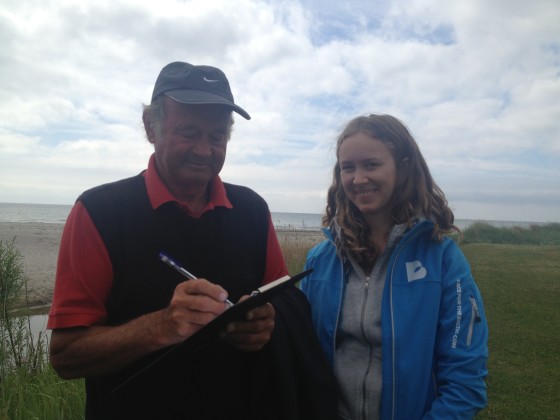
This morning, the team from Race for the Baltic met with local landowner Karl-Otto Alwén at the Tullstorp Stream outside Trelleborg in Skåne, Sweden. It is the first of a number of local initiatives contributing to a better Baltic Sea environment that the campaign wants to highlight along the way.
The Tullstorp Stream is the focus of a pilot project which aims to reduce nutrient run-off into the Baltic Sea, while recreating natural habitat for fish and it could become a model for water management in the region. It is based on collaboration between landowners along the stream and the local municipality Trelleborg.
The cycle team and FISH staff met with Karl-Otto Alwén, one of the landowners that have been involved with the project from the start, at the river mouth where it meets the Baltic Sea. He told us how the landowners had joined together on a voluntary basis to work with improvements in water quality, as well as habitat restoration, in order to meet new demands under the EU Water Framework Directive.
– We felt it was better to do it ourselves, rather than being forced by the authorities to take action, says Karl-Otto Alwén. Through the joint project, we can do it in our own way and test different solutions.
An area of around 7 000 hectares of agricultural land is affected by the project, most of it active farmland. When the project started in 2009, the nutrient run-off from the stream contained 250 tonnes of nitrogen and 4 tonnes of phosphorus. Together, the people involved in the project aim to remove 80 tonnes of nitrogen and 2.1 tonnes of phosphorus per year before the water in the stream reaches the sea.
The project really began as an inventory of wetland areas along the stream, and re-creation of wetlands has been a main focus of the work. They have created 30 wetlands so far, with another 30 planned. They have also created water reservoirs that can receive surplus water when the water levels are exceptional in order to slow down the water flow, thereby decreasing run-off into the sea.
Among the range of efforts made so far, the natural turns and bends in the stream have also been recreated. It now has a more meandering path, with a slower flow. Together with restoration of important habitats and fish spawning sites along the stream bed, this has led to an increase in general biodiversity and particularly fish. They have seen species such as trout, Baltic salmon, eel and Northern pike return to the strea in greater numbers.
Through careful monthly monitoring, they collect data to assess the effects of the work they are doing, both in terms of biodiversity and nutrient levels. This makes it a perfect pilot for other efforts in the region, as there will be documentation on the effectiveness of different measures.
The Tullstorp Stream Project will run for at least another 4 years. The group has other ideas in the pipeline, such as attempts to cultivate some wetland areas and then harvest the growth for production of biogas. They are also testing a new chalk filter for a point source of phosphorus. The association is now trying to engage around 40 local, small-scale businesses in the work as well.
For more information about the project and the Tullstorp Stream: